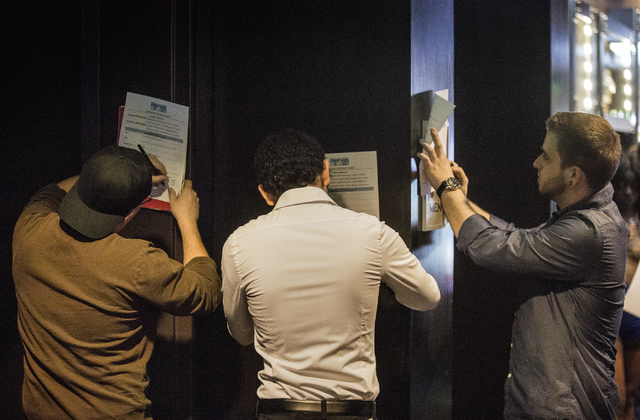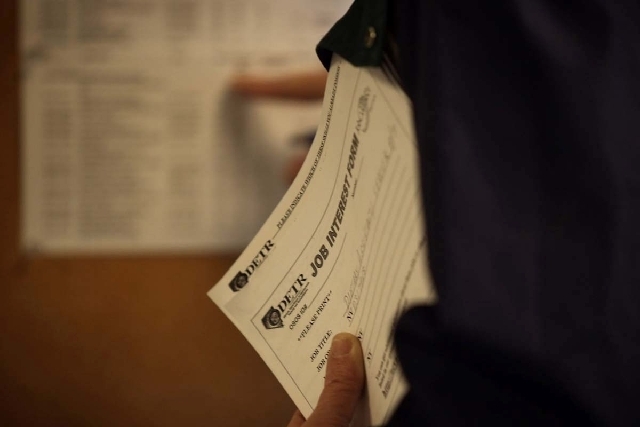Nevada leads U.S. in job creation, no longer tops nation in unemployment
Hey, Nevadans: It’s getting safer to leave your foxholes.
The recession’s war on the Silver State’s jobs market appeared to relent noticeably in December and January, as a barrage of indicators pointed to sustained recovery.
But it’s an uneasy peace, and the state still has much jobs territory to recapture.
“We are far from recovered, and we are far from reaching back to peak employment levels,” said Brian Gordon, a principal in local research firm Applied Analysis. “We’re putting more distance between the floor and where we are today, and that’s a sign of increased stability. But by no means are we out of the woods.”
Consider first how little ground Las Vegas and Nevada made up in January jobless rates. Local unemployment stayed at 8.9 percent from December to January, while joblessness across Nevada fell from 9 percent to 8.7 percent in the same period, said a Monday report from the state Department of Employment, Training and Rehabilitation. The state seasonally adjusts state rates but not national ones, so sometimes jobless levels between the two look out of step.
Yet, Nevada flashed signs that its overall economic performance is finally improving.
As it did during the boom, the state led the nation in job formation year over year in January, with a 3.4 percent growth rate, said Bill Anderson, chief economist for the employment department. That’s compared to a national average of 1.7 percent.
What’s more, federally adjusted data show that Nevada dropped out of the No. 1 spot for unemployment in December and January, the first time in nearly four years that the state was out of the top spot for two straight months. Until December, Nevada had topped the nation in unemployment since May 2010, with the exception of January 2013, when Rhode Island slipped ahead by a tenth of a percentage point. Rhode Island also led the nation in December and January, at more than 9 percent.
MILESTONE IN JOBS CREATED
Nevada’s jobs market hit another milestone in January: The number of jobs statewide exceeded the 1.2 million mark for the first time since 2008.
That’s an important threshold for a couple of reasons, said Steve Brown, director of UNLV’s Center for Business and Economic Research.
“A lot of people in Las Vegas and Nevada are looking for signs that growth is sustainable before they start hiring people. If they see favorable trends not only in their own business, but in the economy, that’s more likely to affect their hiring decisions,” Brown said.
Eight of the state’s 10 “super sectors,” which include leisure and hospitality, construction, education and health services, and professional and business services, added jobs year over year in January. Leisure and hospitality added the most, at nearly 12,000 positions statewide.
Gordon said development on the Strip helped gains in leisure and hospitality. The Linq, a $550 million retail and entertainment center that Caesars Entertainment is building between The Quad and the Flamingo, has been opening in phases, and hiring has started at SLS Las Vegas, both of which are likely contributing to the improved numbers, he said.
Also, professional and business services, which includes law firms, accounting firms, architecture studios and employment agencies, grew by nearly 6,000 jobs statewide. Many of the additions trace back to support and administrative services, which means businesses “may be back-filling positions they’ve gone so long without,” Gordon said.“The economic climate is starting to report increased stability, and that may be providing business owners and management with some level of confidence as we move into 2014,” he added.
Nevada’s labor market still lags its pre-recession levels, though.
The Silver State’s jobs base peaked at just under 1.3 million positions in May 2007.
COMPARING WITH 2007
So despite 37 straight months of job growth, Nevada still had 92,000 fewer jobs in January than it had when the recession began in late 2007. That means it’s restored a little more than half of the 170,000 positions employers slashed in the downturn.
Blame continued high unemployment in construction and a relatively weak California economy, Brown said. California, an important feeder for local tourists and new residents, had a January jobless rate of 8.1 percent, compared with the U.S. average of 6.6 percent.
Plus, though it hasn’t ranked No. 1 for unemployment since November, Nevada has merely slipped to No. 2, where it’s tied with Illinois.
And the state’s 3.4 percent growth rate was roughly half of the 6 percent the state averaged before the downturn, though that’s not necessarily a bad thing.
“The kind of environment that fosters 6 percent growth year over year was not sustainable,” Anderson said. “Something more moderate, like what we’re seeing now, is more sustainable going forward.”
Still, should economic conditions hold steady, unemployment should continue to decline through 2014, observers said.
Both Anderson and Brown said the state could shave up to another 1.5 percentage points from its jobless rate, putting unemployment in the low 7 percent range by year’s end.
Contact reporter Jennifer Robison at jrobison@reviewjournal.com. Follow @J_Robison1 on Twitter.


















